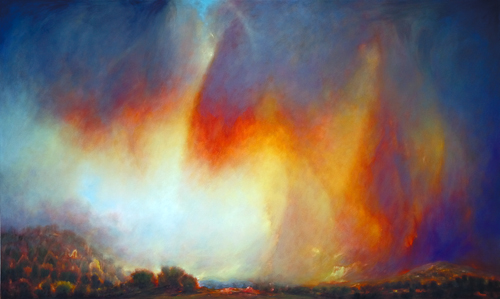
A Very Long Fall oil on canvas 89″x53″
The art world often treats landscapes as a kind of quaint holdover from simpler times, when Thomas Cole, Asher Durand and their Hudson River compatriots were recording the splendors of the American wilderness in effusive splashes of color and light; or, later, when Frederick Remington captured on canvas the mythic proportions of a western landscape already in decline. In the linear development of artistic expression so dear to art historians, landscape can be old news.
Larry Gray begs to differ.
“I remember being part of a group interview of painters the Smithsonian did a while ago,” the Brevard-based artist recalls, “and the other artists were apologetic about the fact they’d ever done landscape painting. But for me, the land is a primary influence.” The sentiment is abundantly borne out by even the most casual glance at the painter’s luminous and deeply spiritual depictions of land and sky. “I can’t recall ever wanting to be anything but an artist,” Larry says, a career choice so successful that his work is now part of the permanent collections of the Museum of Modern Art in New York, the Chicago Art Institute and the Brooklyn Museum of Art, among others.
Larry, now 62, grew up on his grandfather’s farm in the rolling hills of central Tennessee, where he was allowed to roam freely. “That was my first and greatest influence,” Larry explains. “That was when I got very connected to landscape. I became a ‘professional’ at the age of seven, when the older kids on the school bus started paying me to draw pictures for them.” Nearly as compelling as his boyhood Tennessee surroundings was the northern California terrain where, years after graduating from the University of Georgia and Yale, he taught at Humboldt State University. Despite the gravitational pull the two terrains exercised — one on his boyhood imagination and the other on that of a mature artist — none of his works are representative of any actual locale. “I don’t work from photographs or anything like that,” Larry says. “The paintings are composites.”
During his teaching years at Humboldt, Larry first experimented with his trademark use of powdered pigments applied directly to paper, a process he calls ‘hand painting’. It was born of necessity during his seven years at the school. “I loved teaching, but I got put on so many faculty committees and so on that there was very little time for any work in my studio. I realized that if I could eliminate drying time for each piece, I could use that much more time for actually painting, so that’s when I started using the powders.” Such works have an especially ethereal character, as if they’re still in the process of being made before the viewer’s eyes.
But in both these works on paper and in Larry’s more traditional oils on canvas, light and space combine in ways that are at once uplifting and brooding. A thin line of terrestrial geography typically occupies the bottom of each picture, overlooked by a vast sky streaked with light and emotion. The viewer, as firmly bound to the earth as the thin patch at the bottom of the painting, is put squarely in place as a small part of something much larger and more mysterious. “Larry’s work has an enigmatic quality that defies easy interpretation,” says Chris Foley, of Asheville’s Haen Gallery. “There are elements of danger and foreboding, as well as beneficence and hopefulness. The balance between emotion and intellect is pitch perfect.” Chris’ first exposure to Larry’s work was a mural Larry had given to a café in Pisgah Forest, leading to a visit to Larry’s Brevard studio. “My wife and I realized we had found a treasure in our community and we were eager to share it,” Chris says. There followed Larry’s first one-man show in Asheville at Haen last November, with a second devoted to his new work scheduled for next fall. (Larry’s work on paper will be part of a group show opening this month.) A further example of Larry’s strong tie to nature-based art is reflected in an ongoing project: photographing the native plant life of a particularly unspoiled section of the Blue Ridge he discovered some years ago.
“I have a theory that it was the land, the wilderness, that shaped our national consciousness,” Larry says. “The challenges of dealing with all that space, with nature, I think were key to forming the American character. And that wilderness, that sense of space and light, is disappearing now.” But we’ll still have his paintings, reminders of our collective heritage and what may soon be lost.

I love the spiritual power of the work and would love to know more of the technical aspects as well. I’m a Midwesterner, New Yorker and now an Athenian living in Greece. I want to get back into painting at 76 after 2 decades of doing emotional healing work and this work inspires me but will need some technical help. Can’t wait to hear back!!!!!